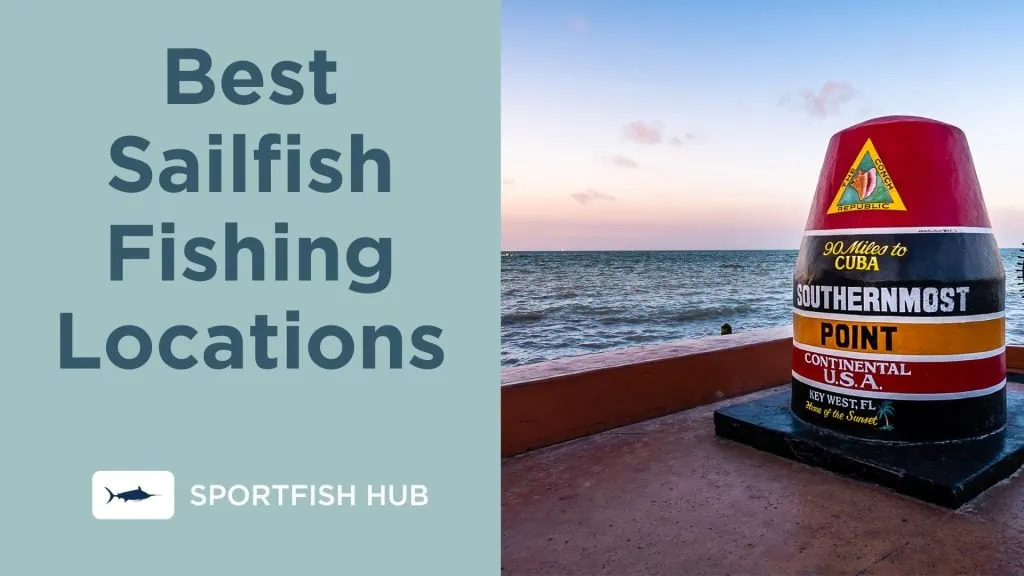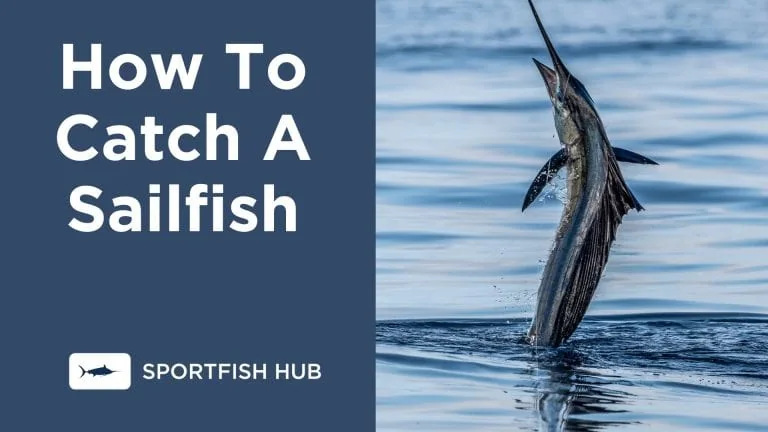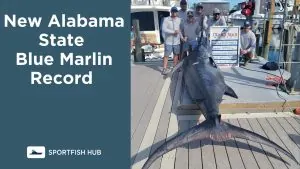Sailfish are one of the most thrilling and challenging game fish for anglers to pursue. Their incredible speed, acrobatic jumps, and brute strength make them a worthy adversary. This comprehensive guide provides everything you’ll need to know to know how to catch a sailfish, from techniques and gear to tips for a successful release.
- Overview of Sailfish
- Best Baits For Sailfish
- Best Sailfish Fishing Locations
- Understand Sailfish Behavior
- 3 Key Techniques for Targeting Sailfish:
- What Depth Do You Fish for Sailfish?
- Recommended Sailfish Fishing Gear
- Fighting and Landing a Sailfish
- Tips for Releasing Sailfish
- FAQ
- What type of leader should I use when sailfish fishing?
- Is sailfishing better on rough or calm sea days?
- What time of day is best for catching sailfish?
- How long should I wait before setting the hook on a sailfish strike?
- Should I use a wire leader for sailfish?
Overview of Sailfish
- Sailfish are known as the fastest fish in the ocean, capable of swimming at speeds over 60 mph. Their streamlined bodies and tall, sail-like dorsal fins are built for speed.
- These billfish are found worldwide in tropical and subtropical waters. They prefer warm ocean currents, areas of upwelling, and near the continental shelf.
- Average sizes range from 5-10 feet long and 60-130 pounds. The all-tackle world record is 141 pounds caught off Key West, Florida.
- Sailfish are ambush predators that eat a variety of baitfish, squid, and crustaceans. Their signature hunting method is to slash through schools of prey with their bills.
See Also: Can You Eat Sailfish?
Best Baits For Sailfish
Selecting the right bait is critical to enticing sailfish to strike. The most effective baits include:
| Bait | Live | Dead | Trolling | Kite |
|---|---|---|---|---|
| Ballyhoo | Yes | Yes | ✓ | ✓ |
| Mullet | Yes | Yes | ✓ | ✓ |
| Pilchards | Yes | No | ✓ | |
| Goggle Eyes | Yes | No | ✓ | ✓ |
| Blue Runners | Yes | No | ✓ | ✓ |
| Squid | No | Yes | ✓ | |
| Sardines | Yes | Yes | ✓ | ✓ |
| Cigar Minnows | Yes | Yes | ✓ |
Live baits like ballyhoo, mullet, and pilchards are top kite fishing and pitch baiting choices. Hook through the nose or lips to keep them lively.
Dead baits can be trolled effectively using skirts and trolling heads. Rig squid, mullet, ballyhoo, or minnows to imitate wounded baitfish.
When sailfish are finicky, downsize lure and bait selections. Small threadfin herring or pilchards can often entice stubborn fish when other baits fail. Match your baits to the existing forage in the area.
Best Sailfish Fishing Locations

Sailfish are very similar to Marlin in that they are found in tropical and subtropical waters around the world. Some top destinations include:
| Location | Country | Notes | Season |
|---|---|---|---|
| South Florida | USA | Keys offer steady action from November through April | Year-round, peak Dec-April |
| Costa Rica | Costa Rica | Known for its abundant sailfish population and great fishing | Dec-April peak |
| Guatemala | Guatemala | More sailfish caught here in a day than almost anywhere. Prized location | Nov-May peak |
| Florida Keys | USA | Famous sail fishing out of Los Sueños, Crocodile Bay, and Quepos. Larger Pacific sailfish here | Nov-April peak |
| Isla Mujeres | Mexico | Known for abundant sailfish population and great fishing | Year-round |
| Los Suenos | Costa Rica | Another legendary Costa Rica sailfishing hotspot | Dec-April peak |
| Puerto Vallarta | Mexico | Top Mexico destination for targeting sailfish | Late fall through spring |
| Kuala Rompin | Malaysia | Indian Ocean offers calm waters and excellent sailfishing | April-October peak |
| Mauritius | Mauritius | Indian Ocean island nation with great sailfishing | Dec-April peak |
| Fiji | Fiji | Offer sailfish action from September through March | Sept-March peak |
Understand Sailfish Behavior
Sailfish exhibit some unique behaviors and preferences that anglers should understand in order to catch them consistently:
- Surface Feeders: Unlike many fish, sailfish hunt almost exclusively near the surface, usually in the top 20 feet of the water column. Their large dorsal fins are constantly visible as they chase prey.
- Constant Swimmers: Sailfish are perpetually on the move, migrating long distances rather than staying in one area. They prefer warmer waters between 70-85°F.
- Reactionary Biters: Sailfish will become more active and feed aggressively when they sense conditions that corral baitfish, like temperature fronts, rips, color/temperature changes, floating debris, and other structure.
- Low Light Feeders: Sailfish do the majority of their feeding early and late in the day during low light conditions. Overcast days can also prolong their feeding activity. Late afternoon is a prime window.
- Speed Demons: Sailfish are the fastest fish in the ocean, capable of bursts up to 68 mph. They rely on speed to catch their prey, making them more difficult to hook.
- Frontal Hunters: Sailfish use their signature “bill whacking” technique to slash through large schools of bait pinned to the surface during frontal conditions. This can cause a frenzy of feeding activity.
- Structure Fans: Natural and artificial structure like reefs, rigs, wrecks, and even floating debris attracts baitfish that sailfish key in on. Fish structure edges and up current sides.
3 Key Techniques for Targeting Sailfish:
1. Trolling For Sailfish
Trolling with natural baits and artificial dredges allows anglers to cover a lot of productive water in search of sailfish. Dredges tease fish in, while natural baits elicit strikes. Follow these tips for success:
- Rig natural baits like ballyhoo or mullet and live baits such as pilchards or goggle eyes on circle hooks and deploy them from outriggers, kites, downriggers, planers, and flat-lines.
- Try trolling speeds from 4-7 knots to mimic the movements of wounded baitfish that trigger predator instinct. Adjust speed to get baits working properly.
- Set baits at different depths between 5-40 feet down, depending on where bait and fish are holding. Vary depths until you find the zone.
- Use dredges to mimic large bait schools. Tune the dredge height to the point fish are slashing through them. Closer is often better.
- Tease fish with dredges but offer live baits trailing behind to facilitate an eat. The lively bait appearance elicits strikes.
- Try running two dredges at different lengths to create a staggered column bait ball effect. This added realism provokes strikes.
2. Bait and Switch (Pitch Bait)
Using a pitch bait is more common with Marlin, but it can still be extremely effective with sailfish. Below are the steps involved with using a pitch bait on Sailfish:
| Step | Description |
|---|---|
| 1 | Deploy a teaser bait like a skirted lure or hookless plug behind the boat to get a sailfish’s attention. |
| 2 | As soon as a fish appears in the spread or shows interest, quickly swap the teaser for a live bait rigged with a circle hook. |
| 3 | Use small lively baits like threadfin herring, ballyhoo, or pilchards for the best action. Match the hatch to the existing forage. |
| 4 | The switch bait should be easily accessible from a bait tube or pen so it can be deployed rapidly. Practice smooth transitions. |
| 5 | Wait until the sailfish turns on the bait and fully commits before completing the switch to ensure its focused on feeding. |
| 6 | If the fish loses interest, go back to the teaser bait and start over. Be patient for multiple opportunities. |
Rigging Ballyhoo Baits For Trolling
Ballyhoo make excellent baits for sailfish. Follow these rigging tips for a more successful hook-up rate:
| Hook Style | Hook Size | Positioning Tips |
|---|---|---|
| Circle Hook | 6/0-8/0 | Hook through both lips or nose for short strikes |
| J-Hook | 4/0-6/0 | Inhale hook near throat without protruding for solid hooksets |
| Non-Offset | 6/0-8/0 | Tip facing down through top of nose to ride naturally |
- Use 60-80lb fluorocarbon leader material for abrasion resistance
- Add colorful squid or bay anchovy skirts for attraction
- Keep baits lively in circulating livewells
- Change out baits every 20-30 minutes for freshness
3. Kite Fishing with Live Baits
Kite fishing is a specialized technique to present live baits to sailfish offshore. It involves suspending baits under a kite that is specifically designed for fishing.
- Kite fishing allows baits to be fished near the surface while covering a wide search area to locate sailfish.
- Live baits like goggle eyes, ballyhoo, blue runners, or threadfins are rigged on circle hooks and clipped to the kite lines.
- The kite mimics struggling baitfish near the surface to provoke strikes from sailfish, playing to their instinct to attack from below.
- Proper kite position upwind and bait clip tuning is key to presenting baits naturally. Leader from 80lb-100lb prevents cutoffs.
- Let out sufficient line length to allow baits to swim well. Use teaser baits and multiple hook baits per kite for best results.
Kite fishing takes specialized equipment and practice but is a deadly technique for targeting sailfish offshore. For detailed information on setting up kite fishing spreads, see our complete guide on how to kite fish.
What Depth Do You Fish for Sailfish?
When targeting sailfish, focusing on the right fishing depths is key to success. Here are some tips on sailfish depths:
- Sailfish spend much of their time hunting between 90 and 200 feet below the surface. This is a prime starting depth range to target them.
- When live-baiting for sailfish, setting baits down at approximately 20 and 50 feet is effective for covering depth zones.
- Sailfish often feed and hunt in the upper water column near the surface anywhere from 30 to 65 feet deep where baitfish congregate.
- In some conditions, sailfish have been observed in very shallow waters as shallow as 20 feet when actively chasing baitfish.
- To specifically target sailfish, aim to get your baits down to the 30 to 65 foot depth range where sailfish are likely patrolling.
Recommended Sailfish Fishing Gear
- Rod: Medium-heavy to heavy offshore trolling rods or stand-up rods rated for 30-80 lb line.
- Reel: Lever drag reels that hold 200+ yards of 50-80 lb braided line. High speed 6:1 gear ratio or higher.
- Line: Use braided lines from 30-80 lb test. Braid handles heat better at high speeds.
- Terminal tackle: Circle hooks from 6/0-8/0 or stronger J-hooks. Fluorocarbon leader 60-100 lb test.
- Lures: Ilander lures, jet heads, ballyhoo rigs. Moldcraft Wide Range or Super Chugger for trolling.
- Kite fishing: Heavy-duty kites, clips, swivels and gear rated for offshore use.
Fighting and Landing a Sailfish
Use these tactics once hooked up:
- Keep tension on the line and use a stripping technique to reel rather than winding quickly
- Let the sailfish make initial long runs to tire itself out before gaining line back
- Keep the rod tip down and the sailfish’s head up to maintain control
- Back down on the reel drag incrementally as you get the fish boat side
- Use a landing net or tail rope to secure the sailfish once subdued
Tips for Releasing Sailfish
- Keep the sailfish in the water when releasing. Don’t remove it from the water if possible.
- Move the boat forward slowly to pump water over the gills and revive the fish.
- Avoid excessive jerking when setting the hook to prevent deep hooking injury.
- Use circle hooks to promote hook sets in the corner of the mouth for easier release.
- Follow regulations on sailfish, including size limits, bag limits, and closed seasons.
With the right techniques, equipment, and knowledge, you can experience the thrill of catching sailfish. Use this comprehensive guide to plan your next successful sailfish fishing adventure!
FAQ
-
What type of leader should I use when sailfish fishing?
Fluorocarbon leader in the 60-100lb range provides low visibility, abrasion resistance, and strength for sailfish.
-
Is sailfishing better on rough or calm sea days?
Sailfish tend to feed best on choppy days that bait gets corralled compared to flat calm conditions.
-
What time of day is best for catching sailfish?
Early morning and late afternoon when sailfish are actively feeding near the surface.
-
How long should I wait before setting the hook on a sailfish strike?
Sailfish usually need a few seconds to eat your baits, and although every bite is different, waiting about 5 to 10 seconds before bumping up your drag is recommended.
-
Should I use a wire leader for sailfish?
No, use heavy fluorocarbon leader instead. Wire leader is visible and can reduce strikes.












